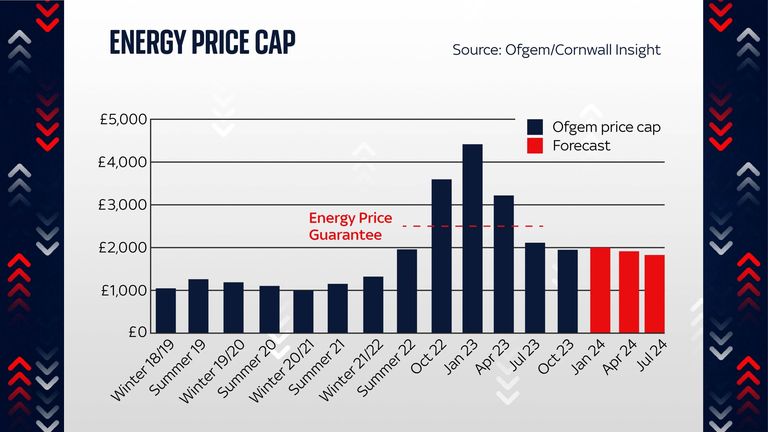The energy regulator has confirmed a cut to its price cap that will see average household bills come down this autumn, as experts continue to warn of hikes to come during the winter months.
Ofgem said the typical household paying by direct debit for gas and electricity faces an annual charge of £1,923 from October to December.
That was down from the £2,074 level set for the three months to the end of September, bringing some further relief to consumers still grappling with the effects of the energy-driven cost of living crisis.
The price a supplier can charge for gas is falling from 6.9p to 6.89p per kilowatt hour (kWh) – with the cost of electricity dropping from 30.1p per kWh to 27.35p.
The reduction is largely explained by weaker wholesale prices – and Ofgem says the market is stabilising, with suppliers returning to a healthier financial position.
The price cap would have been lower still, by a further £100, if it had reflected a looming Ofgem calculation that gives a nod to reduced energy use.
Ofgem chief executive Jonathan Brearley said: “It is welcome news that the price cap continues to fall, however, we know people are struggling with the wider cost of living challenges and I can’t offer any certainty that things will ease this winter.”
The regulator has also unveiled measures to reduce costs for prepayment meter customers – alongside extra support for those at risk of disconnection from the network.
But there has also been a small increase to the earnings that energy firms can make per household – an extra £10 a year – most of which is ringfenced in the event of a supplier failure.
Ofgem says that, at the peak of the energy crisis, 30 suppliers went bust because they didn’t have enough capital in reserve to stay in business – adding £83 to the bills of all customers.
Household consumption has fallen sharply following the bill shocks of the past 18 months.
However, there are warnings from industry forecasts that peak winter will likely see bills rise back above the £2,000 mark.
The next price cap announcement – covering January to March 2024 – will be made in three months’ time.
Energy Security Secretary Grant Shapps described October’s fall as “encouraging” – and claimed it was another milestone in the government’s promise to halve inflation.
“We are successfully driving Putin out of global energy markets so he can never again hold us to ransom, and we are boosting our energy independence to deliver cheaper, cleaner and more secure energy to British homes,” he added.
But Labour’s shadow energy and net zero secretary, Ed Miliband, claimed the latest price cap announcement “demonstrates the scandalous Tory cost of living crisis is still raging for millions of people”.
He claimed the government was siding with oil and gas companies making record profits, adding: “Higher energy bills are unfortunately here to stay under the Conservatives, even with this fall, bills are significantly higher than they were only three years ago.”
Read more:
Cost of living latest – as supermarket cuts prices
Meanwhile, a thinktank has declared millions of the poorest households will pay more despite the price cap cut.
The Resolution Foundation blamed the withdrawal of energy support schemes and a rise in charges added to bills.
The price cap sets a limit on the amount suppliers can charge for each unit of gas and electricity used and for the privilege of being connected to the energy network. The more you use, the more you pay.
Even at the reduced cap mark, it remains about £800 above 2019 levels at a time when families are dealing with high inflation and higher housing costs – mostly as a consequence of interest rate rises by the Bank of England intended to dull the pace of price rises in the economy.
Ofgem has said it now expects suppliers to continue improving service and support their most vulnerable customers.

